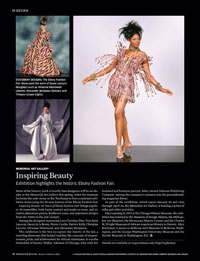In Review
 STATEMENT DESIGNS: The Ebony Fashion Fair showcased the work of haute couture designers such as Tilmann Grawe (above). (Photo: courtesy of Johnson Publishing Company)
STATEMENT DESIGNS: The Ebony Fashion Fair showcased the work of haute couture designers such as Tilmann Grawe (above). (Photo: courtesy of Johnson Publishing Company) WORLD VIEW: The exhibition features 40 ensembles from some of the world’s most prominent designers and design houses, including France’s Emmanuel Ungaro (above). (Photo: courtesy of Johnson Publishing Company)
WORLD VIEW: The exhibition features 40 ensembles from some of the world’s most prominent designers and design houses, including France’s Emmanuel Ungaro (above). (Photo: courtesy of Johnson Publishing Company)Some of the historic work of world-class designers will be on display at the Memorial Art Gallery this spring, when the museum becomes the only venue in the Northeast to host a national exhibition showcasing the 50-year history of the Ebony Fashion Fair.
Inspiring Beauty: 50 Years of Ebony Fashion Fair brings together 40 ensembles, both haute couture and ready-to-wear, and includes glamorous gowns, feathered coats, and statement designs from the 1960s to the 21st century.
Among the designers represented are Christian Dior, Yves Saint Laurent, Oscar de la Renta, Pierre Cardin, Patrick Kelly, Christian Lacroix, Vivienne Westwood, and Alexander McQueen.
The exhibition is the first to explore the history of the fair, a traveling showcase that helped redefine the concepts of empowerment, pride, and achievement for African Americans. It was the brainchild of Eunice Walker Johnson of Chicago, who with her husband and business partner, John, owned Johnson Publishing Company. Among the company’s ventures was the groundbreaking magazine Ebony.
As part of the exhibition, which opens January 30 and runs through April 24, the Memorial Art Gallery is hosting a series of talks and other activities.
Since opening in 2013 at the Chicago History Museum, the exhibition has traveled to the Museum of Design Atlanta, the Milwaukee Art Museum, the Minnesota History Center, and the Charles H. Wright Museum of African American History in Detroit. After Rochester, it moves to Bellevue Arts Museum in Bellevue, Washington, and the George Washington University Museum and the Textile Museum in Washington, D.C.
Details are available at the museum’s website.

